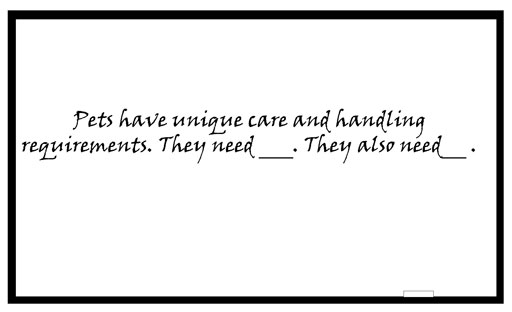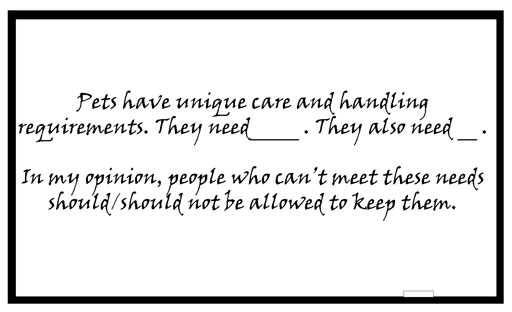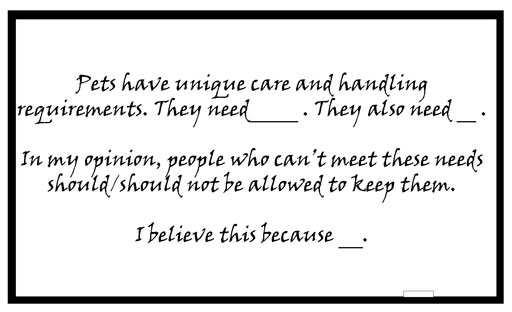3 Helping students to write independently by modelling language
In Case Study 1, the teacher helped students to write their answers to questions about a text by modelling the answer and giving students some of the language that they needed to compose their responses. Giving students the models or writing frames helps them to slowly build up the skills that they need to write independently.
Here are some different ways that you can provide help:
- Missing words: Provide a text that has words or sentences missing, and that students have to complete themselves. Leave out words or short phrases that students can find in a reading passage. This gives students a lot of support, and works well with well-known stories or summaries of a lesson, for example:
- Anne Frank had a father, a mother and ________. She was born in ________ in ________. The family emigrated to ________, and she went to ________.
- Models: Provide a complete text that students change according to their own contexts. For example, give a description of your mother or father, and ask students to change the key words to describe their own mother or father. Students who are more confident at writing can make more changes and use more of their own language.
- Writing frames: Provide a writing frame of a text that gives students a structure to follow: a formal letter, for example. You can support students more by giving them more information: sentences, sentence prompts, key vocabulary and so on. As students become more familiar with writing formal letters, you can give them less support (see Resource 2 for a sample writing frame).
Now read about how one teacher uses the ‘missing words’ technique in the next case study.
Case Study 2: Mrs Mishra supports his students to write longer texts
Mrs Mishra teaches English to Class IX. She recently tried an activity to help her students to write independently in English by supporting them with the language they needed to do a writing activity at the end of a lesson.
At the end of the chapter that we were studying (in the NCERT Class IX textbook Beehive), there was a writing task:
Pets have unique care and handling requirements and should only be kept by those with the commitment to understand and meet their needs. Give your argument in support of or against this statement.
I knew that it would be too difficult for most of my students to write this paragraph – first of all, they wouldn’t really know what to say! So I asked my students to spend a few minutes discussing what requirements pets need. This allowed them to generate some ideas for what they wanted to write. As they were talking, I wrote the following sentences on the board:
When I had finished, I asked students to give some suggestions. A couple of students raised their hands and suggested that animals needed food, water and someone to take care of them if they are ill. I then added some more sentences on the board.
I asked my class to raise their hands if they thought that people who couldn’t meet the needs should be allowed to keep pets. Not many students raised their hands – just a few. I asked Prajit why he thought so. He said that perhaps people couldn’t meet all of the needs, but maybe they could meet some of them, and that was better for the animal than nothing. He expressed this in his home language, so I asked other students in the class if they could help him say this in English. Together they were able to come up with a reply.
I then asked the class to raise their hands if they thought that only people who can meet the needs should be allowed to keep pets. Most of the students raised their hands. They thought that it was not fair for the pets if they did otherwise. Devang thought that pets were like members of the family. I praised him for expressing his opinion and then helped him to say this in English. Now I added another sentence:
Now there was a model paragraph on the blackboard. I asked students to write the paragraph and to complete it with their own thoughts and ideas. I moved around the class as students worked to help with any questions, and to correct mistakes where I could. At the end, each student had written a paragraph, and I encouraged the students who were more confident to write more, and to give more reasons. I asked one or two students to read out their paragraphs. It led to quite an interesting discussion about animal welfare. I never expected that students would come up with so many interesting ideas. By providing them with support, they were able to express their opinions in English. These kinds of activities are definitely helping my students to improve their writing, so I will continue to try them. [For more on supporting your students, see Resource 3.]
Activity 2: Try in the classroom – helping your students to write a longer text independently
This activity helps your students to write a longer text. You can use it with any class.
- Choose a writing task from your textbook or create a writing task. For example, you could choose a story or a summary of a story or lesson; a formal or informal letter; a report or an article for a newspaper or magazine; an application; a paragraph expressing an opinion about something; or perhaps a description.
- Before class, select one of the techniques described above to help your students undertake the writing task. Depending on the level of your students and the technique you have chosen, you will prepare a text with missing words, a model or a writing frame. You can write this on a large sheet of chart paper and stick it on the blackboard, or write it on the blackboard before class if possible.
- Ask your students to undertake the writing task using the resource you have prepared as a guide. As students work, move around the room to help where necessary. Give your students a time limit.
- When they are ready, ask two or three students to read out their work. The rest of the class should listen to see if they have written something similar or different. Ask other students for comments and additions.
Pause for thought Here are some questions for you to think about after trying this activity. If possible, discuss these questions with a colleague. After trying this activity with your students, consider the following questions:
|
Remember that writing in another language is difficult – there is so much to think about! Be positive and encouraging, and tell your students that they need to practise writing to learn how to write. If most of your students struggled, give them more support next time by giving them more of the language that they need, and help them with ideas about what to say. You can find more ideas for this in the unit Whole-class writing routines.
2 Discussing ideas through groupwork



